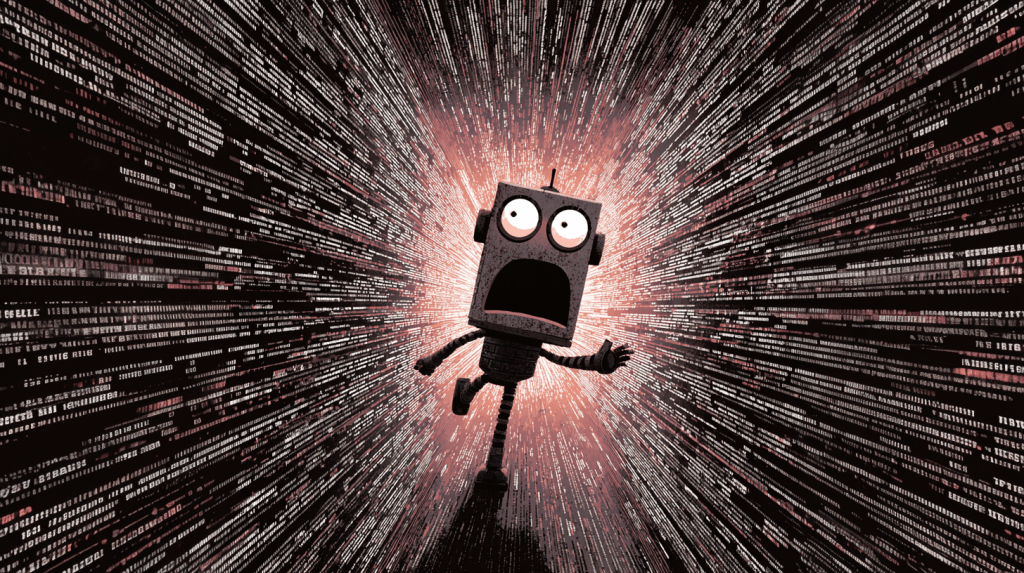Busted by the em dash — AI’s favorite punctuation mark, and how it’s blowing your cover

Want smarter insights in your inbox? Sign up for our weekly newsletters to get only what matters to enterprise AI, data, and security leaders. Subscribe Now
Let’s talk about the em dash. Not the little innocent hyphen, not its slightly more confident cousin, the en dash. No, I’m talking about the ‘EM dash,’ that long, dramatic line that AI looooooves to drop in your sentences like it’s getting paid per dash. Seriously, it’s the AI version of jazz hands.
You may not notice it, but most everyone else does. It’s the dead giveaway that you’ve let your favorite robot sidekick dress your words up in AI drag, and just like a bad wig reveal in the third act of RuPaul’s Drag Race, it can be… a little too much. Let me set the scene: You’re writing a heartfelt email to your team. Something vulnerable, maybe even raw: “I’ve been thinking a lot about the way we work together — and how we can be better — not just as colleagues, but as humans.”
Except, wait. You didn’t write that sentence, AI did. You just wanted it to fix a typo and maybe zhuzh up the tone, but now it’s full of em dashes, introspective pacing and oddly placed poetic pauses. You’ve officially been “EM-marked.”
What is the em-mark for AI?
The em dash is that long horizontal line (—) that’s often used in place of commas, colons, parentheses or the occasional dramatic pause. It’s like the Swiss Army knife of punctuation, and AI LOVES it.
AI Scaling Hits Its Limits
Power caps, rising token costs, and inference delays are reshaping enterprise AI. Join our exclusive salon to discover how top teams are:
- Turning energy into a strategic advantage
- Architecting efficient inference for real throughput gains
- Unlocking competitive ROI with sustainable AI systems
Secure your spot to stay ahead: https://bit.ly/4mwGngO
AI is obsessed with em dashes the way Gen Z is obsessed with Y2K fashion; it’s confusing, oddly stylish, and borderline offensive when overused. But here’s the kicker: AI uses em dashes like sprinkles on a kid’s cupcake, everywhere. Even when it’s not appropriate. Even when you say, “No sprinkles, please.”
I have literally typed to AI: “Please remove the em dashes.” And what do I get back? “Got it!” followed by:“This is a major opportunity — one that demands urgency — and clarity — for maximum impact.” Thanks, GPT. You removed exactly zero.
So, how do you sound human (but still use AI)?
Despite the dash drama, I’m not here to tell you to throw out AI altogether. AI is brilliant at polishing, rephrasing and getting you out of your own mental way. But like a child with glitter glue, you still need to supervise it.
Here are three actually-helpful tips to make sure your communication still sounds like you, not HAL 9000 with a journalism degree.
1. Human first draft, robot second
Always, and I mean always, write the first draft yourself. Let it be messy, typo-riddled, emotionally chaotic and uncomfortably honest. That’s what gives your voice its fingerprints.
Then let AI fix it up, rearrange and suggest better flow, but not before. AI can’t guess what you meant if you don’t give it something to work with first. Otherwise, it just serves you a perfectly punctuated bowl of oatmeal with the emotional depth of a DMV form letter. Think of it like this: You’re the chef, AI is just your fancy sous-chef with a tiny top hat. You tell it what you’re making. You don’t let it invent the recipe.
2. Strip the ems (and other AI tells)
Once AI gives you its best version, rip it apart like you’re editing a screenplay about a talking golden retriever that writes blogs.
Look for:
- Em dashes (obviously)
- The phrase “in today’s fast-paced world” (AI’s favorite opening line)
- Overuse of rhetorical questions
- Repetitive alliteration (AI really thinks it’s clever)
Do a “find and replace” for “—” if you must. Replace them with commas, periods or, God forbid, actual pauses in thought. It’ll instantly humanize your tone. If your sentence feels like it’s being narrated by Morgan Freeman in a nature documentary, it’s probably too AI-ish.
3. Add the ‘you’ back in
After polishing, re-read it aloud. Ask yourself:
- Would I say this out loud at brunch?
- Does this sound like me, or a guest columnist for Forbes trying too hard?
- Did I just accidentally quote Tony Robbins?
If it feels too stiff or polished, loosen it up, add a little slang. Break a grammar rule, use sentence fragments, write like you talk when you’re three mimosas deep and giving your best friend life advice. That’s the secret sauce.
Example:
AI version: “Let’s explore innovative solutions to elevate our business trajectory.”You version: “Let’s figure out how to stop spinning our wheels and actually grow this thing already.”
Feel the difference?
Why you should still use AI, even if it likes em dashes more than is socially acceptable
AI isn’t the enemy, it’s your collaborator, your co-writer, your overachieving intern who drank too much espresso and came back with a 1,200-word mission statement for a brunch flyer.
Use it to:
- Tighten up your message
- Help with structure and flow
- Make your writing pop when you’re brain-fried
- Get past blank-page syndrome without crying
Just don’t let it be the only voice in the room. Think of it like autocorrect, helpful when it’s right, hilarious when it’s wrong and dangerous if you’re not paying attention.
If your message starts sounding like it belongs in a Wall Street Journal op-ed, but you’re just trying to email your VA about a podcast schedule, take a step back, kill the em dashes, reclaim your weird little voice, and remember: AI doesn’t replace you, it just makes you sound 12% smarter… if you supervise it like a helicopter parent at a middle school dance.
Now go forth, edit like a human, delete like a savage and send with swagger. (And please, for the love of all things analog, remove the em dashes.)
Starr Hall is an entrepreneur, veteran publicist and marketer.













